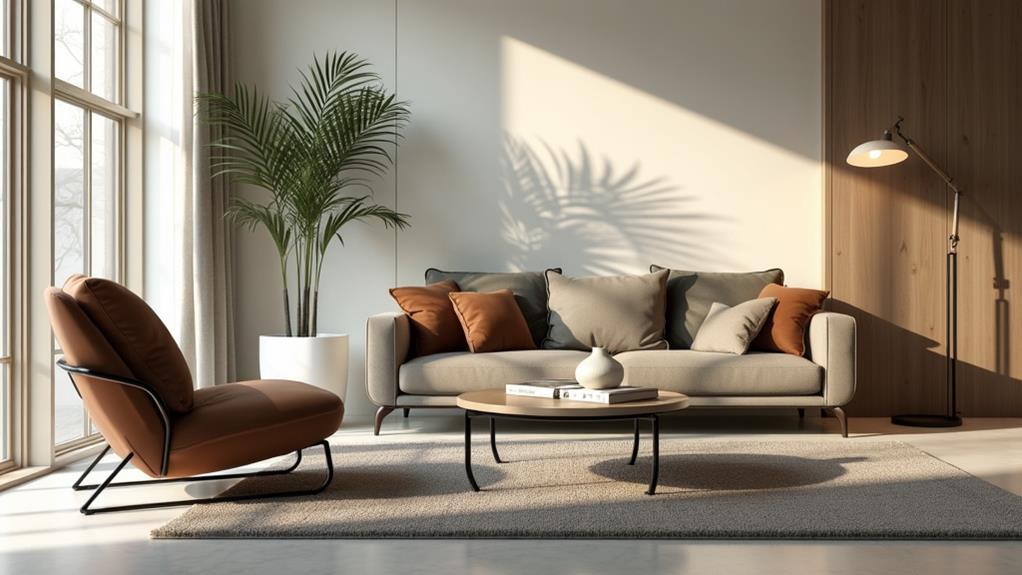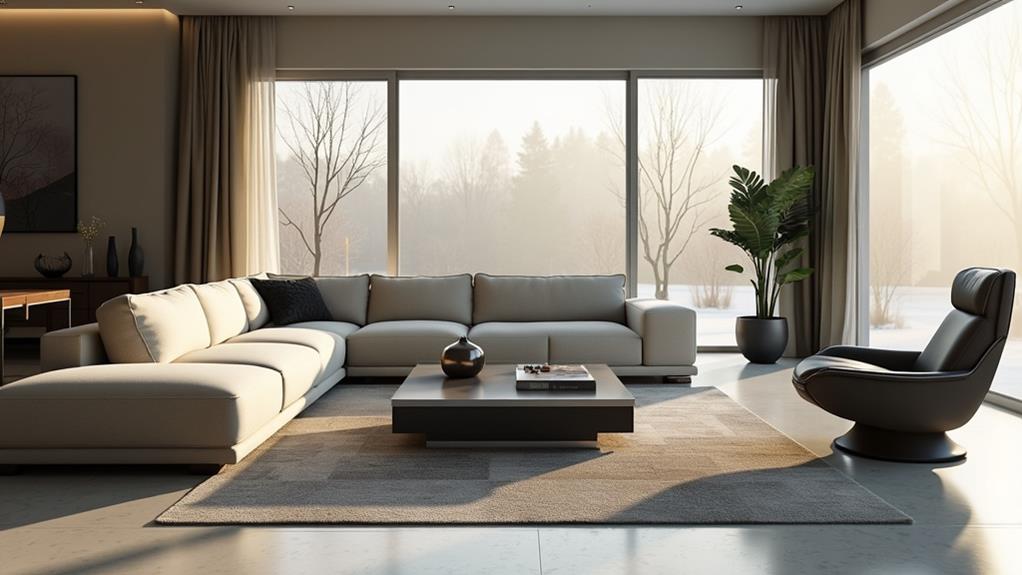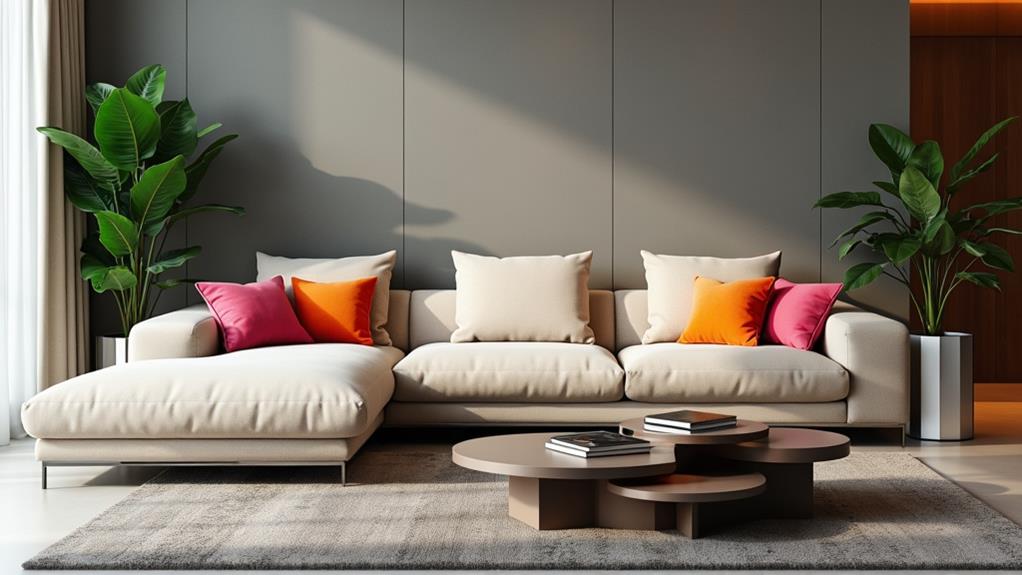As we embrace modernity in furniture design, we redefine comfort by combining advanced ergonomics, sustainable materials, and cutting-edge technology. Ergonomic features support natural postures, alleviating muscle and joint strain, while high-resilience foam cushions guarantee enduring comfort. Sustainable materials, such as bamboo and recycled metals, align with eco-conscious values without sacrificing durability or aesthetics. Modern trends embrace minimalism, multifunctionality, and smart integration, such as built-in charging stations and adjustable systems. This fusion creates versatile, space-optimized furniture that meets diverse needs and preferences, enhancing both functionality and well-being. Expand your understanding of how these innovations shape contemporary comfort and design solutions.
Understanding Comfort in Furniture

When we talk about comfort in furniture, we're diving into a blend of science and personal preference. Comfort isn't just about how something feels when we first sit down; it involves ergonomics, materials, and even psychological factors.
To begin with, ergonomics play an essential role. Our furniture should support our body's natural posture, reducing strain on muscles and joints. For instance, a well-designed chair supports the lumbar region, promoting healthy spine alignment. Additionally, ergonomic seating options are important for ensuring comfort during extended use.
Material choice also considerably impacts comfort. Upholstery should balance softness with durability, ensuring it feels pleasant against the skin while standing up to daily wear and tear. High-resilience foam cushions maintain their shape and provide consistent support, which is crucial for long-term comfort.
Psychological factors can't be overlooked. Colors, shapes, and textures contribute to our overall sense of well-being. A plush, inviting sofa can make a room feel welcoming, enhancing our comfort on a mental level.
Ultimately, understanding comfort in furniture requires us to reflect on these elements collectively. We must balance scientific principles with our individual preferences to create spaces that truly cater to our needs and enhance our daily lives.
Modern Design Trends
Modern design trends in furniture are reshaping the way we think about our living spaces. We've seen a shift towards minimalism, where clean lines and uncluttered spaces dominate. This aesthetic prioritizes functionality and simplicity, resulting in pieces that are both visually appealing and practical.
Materials like metal, glass, and engineered wood have become staples, offering durability and a sleek, modern look. Moreover, solid wood items with sophisticated aesthetics are gaining traction, especially those with various stain finishes that enhance their natural beauty.
Color schemes also play an essential role in contemporary furniture design. Neutral tones, such as whites, grays, and blacks, create a calm and sophisticated atmosphere. However, bold accents and statement pieces, often in vibrant hues, add personality and dynamism to a room.
This balance between subtlety and boldness guarantees that spaces feel both inviting and stylish.
Additionally, sustainability is a key consideration in modern furniture trends. Eco-friendly materials and practices are increasingly popular, reflecting a growing awareness of environmental impact. We see more furniture made from recycled or sustainably sourced materials, highlighting the importance of responsible consumption.
Incorporating smart technology into furniture design is another trend on the rise. Innovative features like built-in charging stations, adjustable settings, and multifunctional elements enhance convenience and adaptability, aligning with our evolving lifestyles.
Importance of Ergonomic Design

Ergonomic design in furniture is a game-changer for our daily comfort and well-being. It's not just about aesthetics; it's about aligning our living spaces with our bodies' natural postures and movements. The significance of ergonomic design lies in its capacity to prevent discomfort and long-term health issues, such as back pain and repetitive strain injuries, by providing support where it's needed most.
When we sit in ergonomic chairs or use height-adjustable desks, we're not only enhancing our comfort but also boosting productivity. Properly designed furniture promotes better posture, reduces strain on muscles, and guarantees that our joints are positioned correctly. This alignment is essential for maintaining our health over time, especially for those of us who spend extended hours sitting or working at desks.
Here's a quick visual representation of key benefits of ergonomic design:
| Benefit | Description |
|---|---|
| Enhanced Comfort | Reduces physical strain, making long hours more bearable |
| Improved Posture | Supports natural body alignment, preventing back issues |
| Increased Productivity | Boosts efficiency by reducing fatigue and discomfort |
Investing in ergonomic furniture is an investment in our health and productivity. It's a practical approach to modern living that prioritizes our well-being.
Embracing Sustainable Materials
As we rethink our approach to furniture, embracing sustainable materials becomes essential. By choosing eco-friendly options, we not only reduce our environmental footprint but also support a burgeoning market for responsibly-sourced goods.
Sustainable materials like bamboo, reclaimed wood, and recycled metals offer durability and a unique aesthetic while minimizing the depletion of natural resources. These choices help us align our lifestyles with ethical consumption practices and foster a healthier planet.
Additionally, the UK bedroom furniture market is expected to see a significant growth rate, which further emphasizes the importance of sustainable practices within this expanding sector.
Employing materials such as bamboo, which grows rapidly and requires minimal pesticides, or reclaimed wood, which repurposes existing resources, guarantees that our furniture choices contribute positively to the environment.
Additionally, opting for recycled metals reduces the demand for virgin ore extraction, further diminishing environmental impact.
These sustainable alternatives often match or surpass traditional materials regarding quality and longevity, proving that eco-friendly options need not compromise on performance or aesthetics.
Multifunctional Furniture Versatility

While we champion the use of sustainable materials in our furniture, it's equally important to contemplate how versatile our furniture can be. Multifunctional furniture is a cornerstone of modern design, offering practicality and adaptability in our increasingly dynamic living spaces. For instance, a sofa that transforms into a bed, or a coffee table with hidden storage, exemplifies how a single piece can serve multiple purposes, optimizing space and functionality.
In today's world, where urban living often means smaller apartments, multifunctional furniture becomes not just a luxury but a necessity. We need pieces that can adapt to our changing needs, whether it's accommodating guests, creating a home office, or simply maximizing limited square footage.
This versatility extends beyond residential settings; offices and public spaces also benefit from furniture that can be easily reconfigured to suit various activities.
Moreover, multifunctional furniture aligns with sustainable living principles by reducing the need for multiple separate pieces, thereby minimizing waste and resource consumption. It's a practical solution that addresses both spatial constraints and environmental concerns.
Personalized Design Norms
In our quest for the perfect living space, personalized design norms have become paramount. As we aim to make our homes more reflective of our individual tastes and needs, the importance of bespoke furniture solutions has surged. No longer do one-size-fits-all pieces suffice; instead, we seek furnishings that cater to our unique lifestyles and aesthetic preferences. By customizing materials, colors, and configurations, we can create environments that aren't only functional but also deeply personal.
Personalized design incorporates elements like modularity and adaptability, allowing us to tailor furniture to fit our spaces and daily routines. For instance, adjustable shelving systems enable us to reconfigure storage solutions based on changing needs, while customizable sofas and chairs offer varying levels of support and comfort. This attention to individuality extends beyond mere aesthetics, emphasizing ergonomic design and user-centric functionality.
Moreover, the rise of sustainable and locally-sourced materials has added another layer to personalized design norms. By choosing eco-friendly options and supporting local artisans, we contribute to a more sustainable and ethically-conscious lifestyle.
Technology Integration in Furniture

With the rapid advancement of technology, our furniture is evolving to meet the demands of modern living.
We're witnessing an era where traditional furniture design is being revolutionized by the integration of smart technologies, transforming our homes into interactive living spaces. For instance, smart sofas now come equipped with built-in speakers, wireless charging pads, and even USB ports, providing both comfort and functionality.
Moreover, adjustable smart beds, which can be controlled via smartphone apps, allow us to customize our sleeping experience by adjusting the bed's position, firmness, and even temperature. This integration of technology enhances our daily comfort and convenience, aligning our furniture with our increasingly connected lifestyles.
In our living rooms, smart coffee tables offer features like refrigeration units to keep beverages cool and Bluetooth-enabled speakers for entertainment.
Such innovations aren't merely gimmicks; they reflect a growing trend towards multifunctional and adaptive furniture that caters to our diverse needs. As we continue to embrace these technological advancements, our living spaces are becoming more efficient, adaptable, and tailored to our personal preferences, ultimately redefining the very essence of comfort in our homes.
Benefits of Modern Comfort Furniture
Modern comfort furniture offers a multitude of benefits that enhance our everyday lives. To begin with, ergonomics play an essential role in modern designs, ensuring that our bodies are well-supported during prolonged periods of sitting or lounging. This attention to ergonomic principles reduces the risk of discomfort and musculoskeletal problems, allowing us to work or relax more efficiently and comfortably.
Moreover, modern comfort furniture often incorporates high-quality materials that improve durability and aesthetics. These materials, such as memory foam, high-resilience foam, and breathable fabrics, provide a luxurious feel while maintaining their shape and support over time. This results in furniture that not only looks good but also remains functional and comfortable for years.
Another significant benefit is the versatility and adaptability of modern comfort furniture. Many pieces are designed with multi-functionality in mind, such as sofas that convert into beds or modular units that can be reconfigured to suit different spaces and needs. This adaptability makes it easier for us to optimize our living environments, accommodating various activities and preferences without compromising on comfort.
Lastly, modern comfort furniture often includes innovative features like built-in USB ports, wireless charging pads, and smart technology integration, enhancing our convenience and connectivity.
Choosing the Right Comfort Furniture

As we appreciate the numerous benefits that modern comfort furniture brings to our lives, it's important to focus on how to choose the right pieces for our specific needs.
The first step involves understanding our personal preferences and the functional requirements of the space. A thorough assessment of our daily activities and the amount of time we spend using the furniture helps us pinpoint what features are essential, such as ergonomic support for an office chair or plush cushioning for a living room sofa.
Next, we should consider the materials and construction quality. High-density foam, durable fabrics, and solid wood frames often indicate longevity and sustained comfort.
It's wise to research and read reviews about different brands and models, ensuring they meet industry standards and customer satisfaction.
Additionally, we mustn't overlook the importance of aesthetics. Modern comfort furniture should seamlessly integrate with our existing décor, enhancing the overall ambiance without compromising on comfort.
Visiting showrooms or viewing detailed online images can aid in visualizing how a piece will fit within our home.

